英文科技论文写作HOW_to_WRITE_Discussion
How_to_write_an_argumentation如何写英语议论文汇总
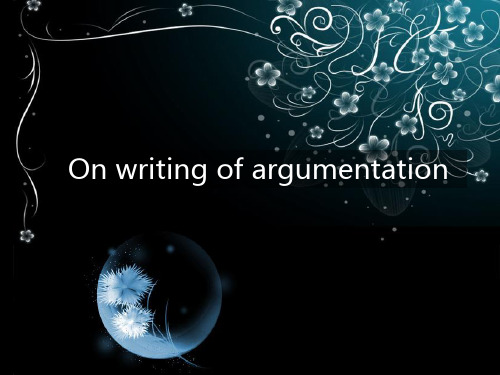
Disadvantages
- Addiction to the Internet, especially online games will exert adverse influence over people’s life, work and study.
- It is harmful to our health to spend too much time surfing online.
- Pornographic websites will lead te or off Campus
To live on campus - more opportunities to expose oneself to
例1: Why should the climate be warmer in the Southern Hemisphere? One reason may be that most of the Earth’s land mass is in the Northern Hemisphere, while our oceans are mostly in the southern half of the world. Water does not absorb sunlight in the same way land does. Also, industrial pollution is much heavier in the Northern Hemisphere, where it may be acting as a sunlight blocker.
科技献策英语作文高中
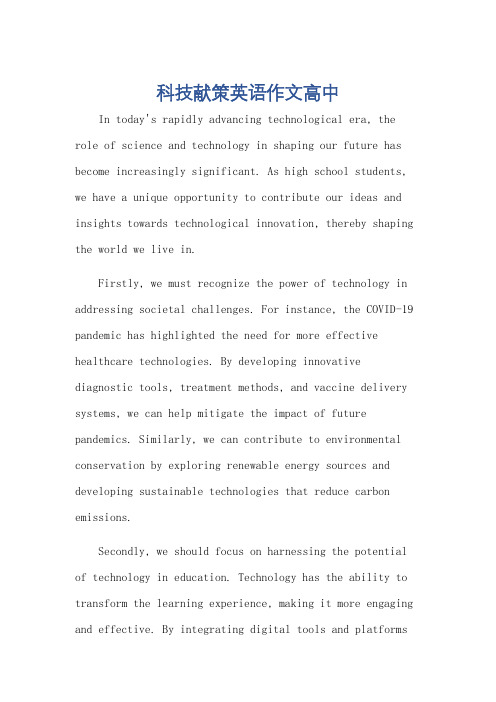
科技献策英语作文高中In today's rapidly advancing technological era, the role of science and technology in shaping our future has become increasingly significant. As high school students, we have a unique opportunity to contribute our ideas and insights towards technological innovation, thereby shaping the world we live in.Firstly, we must recognize the power of technology in addressing societal challenges. For instance, the COVID-19 pandemic has highlighted the need for more effective healthcare technologies. By developing innovative diagnostic tools, treatment methods, and vaccine delivery systems, we can help mitigate the impact of future pandemics. Similarly, we can contribute to environmental conservation by exploring renewable energy sources and developing sustainable technologies that reduce carbon emissions.Secondly, we should focus on harnessing the potential of technology in education. Technology has the ability to transform the learning experience, making it more engaging and effective. By integrating digital tools and platformsinto our learning process, we can enhance our understanding of complex concepts and improve our learning outcomes. Additionally, technology can help bridge the gaps in access to education by connecting students from remote areas with high-quality educational resources.Moreover, we must also consider the ethicalimplications of technological advancements. As we develop new technologies, it is crucial that we prioritize the welfare of society and the environment. We must ensure that our technological innovations are ethical, sustainable, and beneficial to all.In conclusion, as high school students, we have the ability to make meaningful contributions towards technological innovation. By leveraging our knowledge, creativity, and passion, we can shape a brighter and more sustainable future for ourselves and generations to come. Let us seize this opportunity and contribute our ideas and insights towards building a world that is powered by innovation and driven by technology.**科技献策:塑造未来的创新力量**在当今科技飞速发展的时代,科技在塑造我们的未来方面发挥着越来越重要的作用。
如何解决科技问题英文作文
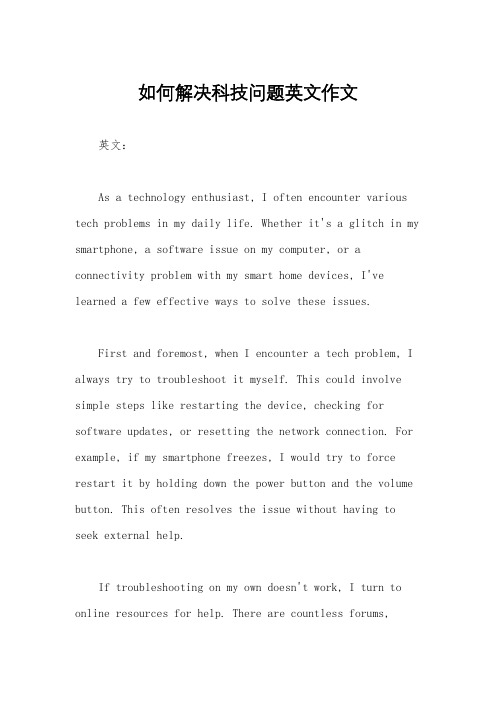
如何解决科技问题英文作文英文:As a technology enthusiast, I often encounter various tech problems in my daily life. Whether it's a glitch in my smartphone, a software issue on my computer, or a connectivity problem with my smart home devices, I've learned a few effective ways to solve these issues.First and foremost, when I encounter a tech problem, I always try to troubleshoot it myself. This could involve simple steps like restarting the device, checking for software updates, or resetting the network connection. For example, if my smartphone freezes, I would try to force restart it by holding down the power button and the volume button. This often resolves the issue without having to seek external help.If troubleshooting on my own doesn't work, I turn to online resources for help. There are countless forums,blogs, and websites dedicated to tech support where people share their experiences and solutions to various tech problems. For instance, when I encountered a strange error message on my computer, I searched online and found a forum where someone had experienced the same issue and provided a step-by-step guide to resolve it.In some cases, when the problem is beyond my understanding, I seek help from tech support professionals. This could be through the customer service hotline, live chat support, or even visiting a tech store for in-person assistance. I remember once when my smart home device was not connecting to the Wi-Fi, I contacted the manufacturer's customer service and they guided me through a series of troubleshooting steps which eventually solved the problem.In addition to these methods, I also make sure to stay updated with the latest tech news and developments. This helps me anticipate and prevent potential tech problems before they even occur. For example, when I heard about a security vulnerability in a certain software I was using, I immediately updated it to the latest version to ensure mydata and privacy were protected.Overall, solving tech problems requires a combinationof patience, resourcefulness, and willingness to seek help when needed. By being proactive and staying informed, I've been able to overcome various tech issues and continue to enjoy the benefits of technology in my daily life.中文:作为一个科技爱好者,我在日常生活中经常遇到各种技术问题。
科技论文写作_第八章(讨论部分)

些应用价值?
第八章 讨论部分
大部分领域中,讨论部分常常位于结果部分后和结论 部分之前。
在一些领域中,讨论部分是研究报告的最后一部分; 有些研究论文将讨论部分与结果部分合并在一起
(Results and Discussion); 有些研究论文不出现单独的讨论部分,而是把讨论的
8.2 常用句型与时态
8.2.5 研究方法或结果的限制
(3)表述其他可能的条件与情况会对研究总结果可能产生的何种 影响,则在句中应使用一般现在时态,且在句中动词之前加 上情态动词may或might。
Tests with other kinds of lubricates might yield different results. (4)还可以使用主语We以及admit、recognize之类的动词来直接
果不是,为什么? (2)根据这些结果,作者能做出什么样的结论或推论?如
何解释这些推论? (3)作者的实验结果或理论分析结果是否和其他学者已提
出的结果一致?如果不是,能否说明不一致的原因?
第八章 讨论部分
(4)是否建议还有什么样的试验或理论分析方法可以让研 究者来证实、反驳或扩延作者的研究结果?
(5)这些结果能否支持或反驳作者领域中现有的理论? (6)根据这些结果,作者能否建议现有的理论应如何修正
8.2 常用句型与时态 8.2.6 指出实际应用或新的研究范围
(4)作者提到自己正在进行或打算开展的相关研究 时, 可使用现在进行时或一般将来时,最好用we作为语 。
In the future, we will investigate the effect of using fuel cells for both transportation and electricity applications.
如何写sci英文论文的Discussion
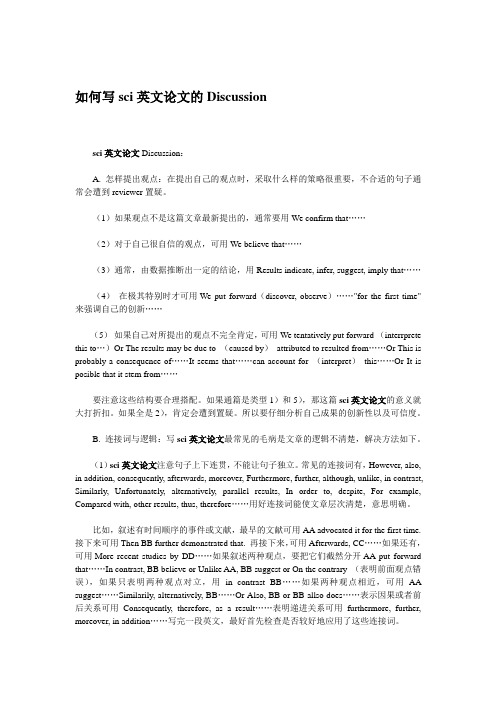
如何写sci英文论文的Discussionsci英文论文Discussion:A. 怎样提出观点:在提出自己的观点时,采取什么样的策略很重要,不合适的句子通常会遭到reviewer置疑。
(1)如果观点不是这篇文章最新提出的,通常要用We confirm that……(2)对于自己很自信的观点,可用We believe that……(3)通常,由数据推断出一定的结论,用Results indicate, infer, suggest, imply that……(4)在极其特别时才可用We put forward(discover, observe)……"for the first time"来强调自己的创新……(5)如果自己对所提出的观点不完全肯定,可用We tentatively put forward (interrprete this to…)Or The results may be due to (caused by)attributed to resulted from……Or This is probably a consequence of……It seems that……can account for (interpret)this……Or It is posible that it stem from……要注意这些结构要合理搭配。
如果通篇是类型1)和5),那这篇sci英文论文的意义就大打折扣。
如果全是2),肯定会遭到置疑。
所以要仔细分析自己成果的创新性以及可信度。
B. 连接词与逻辑:写sci英文论文最常见的毛病是文章的逻辑不清楚,解决方法如下。
(1)sci英文论文注意句子上下连贯,不能让句子独立。
常见的连接词有,However, also, in addition, consequently, afterwards, moreover, Furthermore, further, although, unlike, in contrast, Similarly, Unfortunately, alternatively, parallel results, In order to, despite, For example, Compared with, other results, thus, therefore……用好连接词能使文章层次清楚,意思明确。
如何撰写英文科技论文-How_to_Write_a_Scientific_Paper

我们要如何使用科学技术英语作文
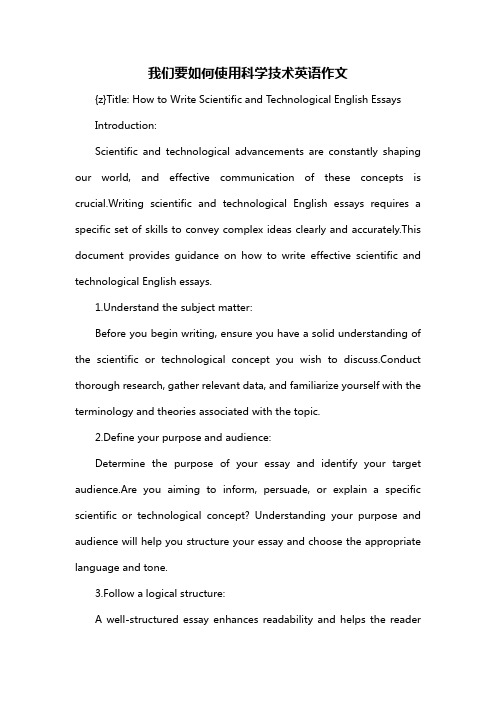
我们要如何使用科学技术英语作文{z}Title: How to Write Scientific and Technological English EssaysIntroduction:Scientific and technological advancements are constantly shaping our world, and effective communication of these concepts is crucial.Writing scientific and technological English essays requires a specific set of skills to convey complex ideas clearly and accurately.This document provides guidance on how to write effective scientific and technological English essays.1.Understand the subject matter:Before you begin writing, ensure you have a solid understanding of the scientific or technological concept you wish to discuss.Conduct thorough research, gather relevant data, and familiarize yourself with the terminology and theories associated with the topic.2.Define your purpose and audience:Determine the purpose of your essay and identify your target audience.Are you aiming to inform, persuade, or explain a specific scientific or technological concept? Understanding your purpose and audience will help you structure your essay and choose the appropriate language and tone.3.Follow a logical structure:A well-structured essay enhances readability and helps the readerfollow your argument.Follow these steps when structuring your essay:a.Introduction: Provide a brief overview of the topic, its significance, and the main points you will discuss.b.Body paragraphs: Each paragraph should focus on a single main idea, supported by relevant evidence and e headings or subheadings to break down complex topics into more manageable sections.c.Conclusion: Summarize the key points discussed in the essay and reiterate the importance of the topic.Offer possible implications or future directions for further research, if applicable.e clear and concise language:Scientific and technological essays require precise language to convey complex ideas e clear, concise sentences and avoid jargon or overly complex terminology unless it is necessary for the reader to understand the concept.Define any specialized terms or acronyms used in your essay.5.Provide evidence and examples:Support your arguments with evidence, data, and relevant examples.Cite any sources used in your research to provide credibility to your e tables, graphs, or images if necessary to illustrate complexdata or concepts.6.Edit and proofread:After completing your essay, take the time to edit and proofread it for any grammatical or spelling errors.Ensure that your essay flows logically and that each paragraph is well-connected.Consider seeking feedback from a peer or instructor to improve the quality of your essay.Conclusion:Writing scientific and technological English essays requires a combination of subject knowledge, clear communication, and effective structure.By following the guidelines provided in this document, you can develop the skills necessary to write compelling and accurate scientific and technological essays.。
英文科技论文写作How-to-write-RESULTS

强调结果的创新性和重要性
阐述研究结果对理论或实践 的贡献
讨论结果对未来研究的启示 和影响
指出结果的局限性和不足之 处
汇报人:
,
汇报人:
CONTENTS
PRT ONE
PRT TWO
清晰呈现研究结果 突出研究亮点和创新点 为结论和讨论提供依据 吸引读者并引导其理解论文的核心内容
明确研究目的和假设 简要介绍研究背景和意义 概述研究方法和实验设计 详细呈现实验结果和数据分析
PRT THREE
研究背景:简要介绍研究领域的现状和问题说明研究的重要性和必要性。 研究目的:明确提出研究的主要问题或假设以及研究要达到的具体目标。
有知识体系。
理论贡献:验证或挑战现有理 论推动学科发展
实践指导:为解决实际问题提 供思路和方法促进技术进步
政策建议:为政府决策提供科 学依据促进社会进步
学术交流:为同行提供研究素 材促进学术验结果:简要介绍实验的主要发现和数据。 对比分析:将实验结果与预期结果或相关研究进行比较。 结论一致性:确保结论与实验设计和假设相一致。 主要发现的意义:阐述实验结果对理论或实践的贡献和影响。
实验目的和意义 实验材料和设备 实验步骤和操作流程 实验结果和数据分析
PRT FOUR
表格:用于呈 现定量数据如 实验结果应简 洁明了避免过
于复杂
图表:用于展 示趋势、比较 等使数据更直 观常用类型有 柱状图、折线
图和饼图
图表设计:颜 色、线条、标 签等应清晰易 读避免过于花
哨
表格和图表应 与文字描述相 互补充共同呈
实验误差或偶然 性:对结果的解 释和讨论应考虑 到实验误差或偶
然性的影响。
样本量或代表性: 讨论结果时应考 虑样本量是否足 够大以及样本是 否具有代表性。
专业英语-结果和讨论

图表的制作与说明(Figures and Tables)-3
图表说明 :
突出重点,明确差异。不是逐次重复图表的内容,而 是将一组数据与另一组作对比,把自己的结果同别人的结 果比,只择其重要者,能支持自己的论点的部分,加以重 点说明。对图表的说明既不应过分详细,也不应过分简单。
图表说明的时态
用小一号的字母按顺序标注。脚注内容直接放在表后。
(6) 数字: 每一栏的阿拉伯数字应按位数对齐。
(7) 宽度: 表格宽度应略短语正文, 如超过页面可横过来,上面应在左侧。
(8)长度: 表格最好不要转页,如超过一页长度,可转第二页。在第二页上仍应列
出各栏的标题,并在右上方注明“Table5 (continued)”字样。
Tense Voice Useful sentences
Writing requirements of discussion
1. 对本次实验或观察结果做出理论解释和讨论 ; 2. 将本次结果,与过去及其他研究结果(不同时间、
不同地点、相同或不同的研究对象中的研究结果)相 比较,分析异同,解释产生差别的可能原因,并根据 自己或他人的文献资料,提出自己的见解,实事求是, 有根据地与其他作者商榷 ; 3. 突出本项研究中地新发现、新发明,提出可能原因 ; 4. 分析本次研究地不足,还存在哪些尚未解决地问题, 提出今后急需研究的方向和设想。
图表的制作与说明(Figures and Tables)-1
图(Figures)
(1)名称: 各种绘图和照片通Figure,可缩写为Fig.,+复数为Figs.。第一个字母大
写, 按出现顺序用阿拉伯数码编号, 例如 Fig. 5
(2)图标题: 图标题与图表题不同,一般放在图的下端,上端与图隔开一行,下端与
How to Write an Effective Discussion 译

How to Write an Effective Discussion 如何写作一个有效的讨论Dean R Hess PhD RRT FAARCIntroduction简介Elements to Include in the Discussion讨论需要包含的元素State the Major Findings of the Study表述研究的主要结果Explain the Meaning of the Findings and Why the Findings Are Important解释这些结果的意思以及它们的重要性Relate the Findings to Those of Similar Studies把这些结果同那些类似的研究相关联Consider Alternative Explanations of the Findings考虑一些这些结果的不同解释State the Clinical Relevance of the Find-ings阐述这些结果的临床相关性(临床意义)Acknowledge the Study’s Limitations声明本研究的缺陷Make Suggestions for Further Research 为进一步的研究提供建议Give the “Take-Home Message” in the Form of a Conclusion以结论的形式给出本文的“关键信息”Things to Avoid When Writ-ing the Discussion讨论部分需要避免的一些东西Overinterpretation of the Results结果的过度(不合理的)阐释Unwarranted Speculation毫无根据的猜测Inflating the Importance of the Findings 夸大结果的重要性Tangential Issues偏离主题(乱扯)The “Bully Pulpit”Conclusions That Are Not Supported by the Data没有数据支持的结论Summary总结Explaining the meaning of the results to the reader is the purpose of the discussion section of a research paper. There are ele-ments of the discussion that should be in-cluded and other things that should be avoided. Always write the discussion for the reader; remember that the focus should be to help the reader understand the study and that the highlight should be on the study data.Key words: publishing; writing; manuscripts, medi-cal; communication.一篇文章的讨论部分的目的就是为了给读者解释结果的意思.讨论部分有一些需要包含的元素, 也有一些需要避免的事情.永远为了读者写讨论;记住你的重点是为了帮助读者理解这篇研究, 重点强调的东西需要建立在研究的数据基础上.关键词: 发表; 写作; 文稿; 医学; 交流.[Respir Care 2004;49(10):1238 –1241. © 2004 Daedalus Enterprises]Dean R Hess PhD RRT FAARC is affiliated with the Department of Respiratory Care, Massachu-setts General Hospital, and Harvard Medical School, Boston, Massachusetts.Dean R Hess PhD RRT FAARC presented a version of this article at the RESPIRATORYCARE Journal symposium, “Anatomy of a Research Paper:Science Writing 101,” at the 48th International Respiratory Congress, held October 5–8, 2002, in Tampa, Florida.Correspondence: Dean R Hess PhD RRT FAARC, Respiratory Care, Ellison 401, Massachusetts General Hospital, 55 Fruit Street, Boston MA 02114. E-mail: dhess@.Translated by Xinxiang Fan, M.D., Department of Urology, Sun Yat-sen Memorial Hospital, Sun Yat-sen University, Guangzhou, China. E-mail: fanxinx2005@.All rights reserved. Unauthorized reproduction of this translated article is prohibited.IntroductionYou have carefully written the hypothesis. You have designed the study and collected the data. You have conducted the statistical analysis and grouped the summary results into table and graphs. But what does it mean? Explaining the meaning of the results to the reader is the purpose of the discussion section. Although the discussion comes at the end of the pa-per, you should be thinking about what you will write in the discussion section from the moment that the study is conceived. Questions that you will develop in the discussion should be considered from the study ’s outset. Why is the study important? How does this study relate to previous studies? What are the limitations of the study design? There are elements of the discussion that should be in-cluded and other things that should be avoided (Ta-bles 1 and 2). Most important, always write the dis-cussion for the reader; the discussion is not a forum for you to impress others with your knowledge of the subject. You should be trying to convince the reader of the merits of the study results.简介你已经认真地写了假设. 你已经设计了研究并且收集了数据. 你已经进行了统计分析, 并且把汇总结果分门别类到表格和图表中. 但是它的意义是什么? 讨论的目的是向读者解释结果的意义.尽管讨论在文章的末尾, 但是你从开始构思研究的时候就要思考你将要在讨论部分写些什么. 你在讨论部分遇到的问题需要在研究的开始就要考虑. 为什么这个研究是重要的? 本研究与先前的研究如何相关? 本研究的缺陷? 讨论部分有一些需要包含的元素, 也有一些需要避免的东西(Tables 1 and 2). 最重要的是, 永远是为了读者写讨论; 讨论不是用你对这个主题的知识给他人以深刻印象的论坛. 你应当试图说服读者研究结果的价值所在.Elements to Include in the Discussion 讨论需要包含的元素State the Major Findings of the Study The discussion should begin with a statement of the major findings of the study. This should be the very first paragraph in the discussion. It should be a direct, declarative, and succinct proclamation of the study results. However, it should not include data or reference to the study design. Several examples il-lustrate the point. In a paper by Anton et al 1 the discussion begins with the sentence, “Our results confirm that these nasal and full-face masks are sim-ilarly efficient over 15 min of NPPV with COPD pa-tients recovering from acute hypercapnic respiratory failure. ” This clearly states the most important finding of that study. Fluck et al 2 began the discus-sion section of their paper with the sentence, “Our 陈述研究的主要结果讨论应该以一个对研究主要结果的陈述来开始. 这应该是讨论部分的第一段. 它应该是对研究结果的一个直接的、陈述性的、简洁的宣告. 然而, 它不应该包含研究数据或者提到研究的设计. 有几个例子可以说明这一点. 在Anton et al的一篇文章中, 讨论以这样一个句子来开始, “我们的结果证实, 在从急性高碳酸血症型呼吸衰竭中恢复的COPD病人接受15分钟的NPPV过程中, 鼻腔面罩和全面罩同样地有效.”这句话清楚的陈述了那篇研究最重要的结果. Fluck et al在他们的文章里以findings suggest that ambient light has no statisti-cally significant effect on S pO2 readings and that am-bient light’s effect on S pO2 is clinically unimportant.” That is a good example of a direct, declarative, and succinct proclamation of the study results. 这样一句话来开始讨论, “我们的结果提示背景光对S pO2读取的影响没有统计学意义, 背景光对S pO2的影响在临床上不重要. 这也是一个对研究结果的直接的、陈述性的、简洁的宣告的好例子.Explain the Meaning of the Findings and Why the Findings Are ImportantExplain the Meaning of the Findings and Why the Findings Are Important. No one has thought as long and as hard about your study as you have. As the person who conceived, designed, and conducted the study, the meaning of the results and their im-portance seem obvious to you. However, they might not be so clear for the person reading your paper for the first time. One of the purposes of the discussion is to explain the meaning of the findings and why they are important, without appearing arrogant, condescending, or patronizing. After reading the discussion section, you want the reader to think, “That makes perfect sense. Why hadn’t I thought of that? ” Even if your study findings are provocative, you do not want to force the reader to go through the paper multiple times to figure out what it means; most readers will not go to that effort and your findings will be overlooked, disregarded, and forgot-ten.Relate the Findings to Those of Similar StudiesNo study is so novel and with such a restricted focus that it has no relation to other previously pub-lished papers. The discussion section should relate your study findings to those of other studies. Ques-tions raised by previous studies may have served as the motivation for your study. The findings of other studies may support your findings, which strength-ens the importance of your study results. Stoller et al 解释这些结果的意思以及它们的重要性解释这些结果的意思以及它们为什么重要.对你的研究没有人会像你那样长时间地和努力地思考. 作为这个研究的构思、设计和执行者, 结果的意思以及重要性对你是显而易见的. 然而,对首次阅读你文章的人,它们或许就不是如此清晰. 讨论的一个目的就是解释这些结果的意思以及它们为什么是重要的, 不要显得傲慢, 谦虚, 或者屈尊俯就. 当读完了讨论部分, 你希望读者去想, “这非常有意义. 我为什么没有想到呢?”即使你研究的结果是富有启发性的, 你肯定不想迫使读者反复阅读你的文章来推敲它的意思; 大多数读者不会那么努力,这样的话你的结果就会被忽略, 漠视和遗忘.把这些结果同那些类似的研究相关联没有研究会如此的新颖和局限以至于和之前发表的论文没有关联. 在讨论部分,你应当把你的研究结果同别的研究联系起来. 之前研究提出的问题或许是促使你研究的动力. 别的研究结果或许支持你的结果, 这样会增强你的研究结果的重要性. Stoller et al 3 在之前一个研究的背景下讨论了他们的研究结果: “减少更换in-line吸管的频率可以降低费用,并不增加VAP的发生率,我3 discussed their study results in the context of a previous study by others: “Our finding that changing in-line suction catheters less frequently is associated with lower cost and no higher incidence of VAP rep-licates the findings of a randomized controlled trial conducted by Kollef et al, upon which our amended policy was based.” I t is also important to point out how your study differs from other similar studies. An example can again be drawn from Stoller et al: 3“Certainly, differences in the specific criteria used to define VAP could contribute to the rate differ-ences between the present study and that of Kollef et al. For example, comparison of the criteria for nosocomial pneumonia in our study with the criteria used by Kollef et al shows similar component fea-tures but different rating schemes to establish the diagnosis.”们的结果重复了Kollef et al做的一个随机对照研究的结果, 我们策略的修订也正是基于他们的研究结果.”我们还可以从Stoller et al: 3的研究中来看另外一个例子:“当然, 用来定义VAP的特定标准的差异会引起本研究和Kollef et al的研究之间分级的差异. 例如, 对比我们研究中院内肺炎的标准和Kollef et al采用的标准, 我们就会发现它们有类似的组成特征, 但是确立诊断的分级方案却是不同的.”Consider Alternative Explanations of the FindingsDespite efforts to remain objective and to main-tain equipoise, it is easy to consider only those ex-planations that fit your bias. It is important to re-member that the purpose of research is to discover and not to prove. It is easy to fall into the trap of de-signing the study to prove your bias rather than to discover the truth. When writing the discussion section, it is important to carefully consider all pos-sible explanations for the study results, rather than just those that fit your biases.考虑一些这些结果的不同解释尽管我们力图保持客观和均衡, 我们很容易只考虑那些适合我们见解的解释. 研究的目的是去发现而不是证明, 记住这点很重要. 你很容易陷入一个圈套, 那就是设计了这个研究去证明你的一己之见而不是去发现问题的真相. 当书写讨论部分的时候, 认真地考虑关于研究结果的所有可能的解释很重要, 而不要仅是那些符合你个人见解的解释.State the Clinical Relevance of the Findings 阐述这些结果的临床相关性(临床意义)The reason we conduct studies is usually to im-prove the care of our patients. Thus it is important to cast the findings of your study in the context of clinical practice. For which patients do the results apply and for which do they not apply? Experi-mental studies conducted in the laboratory usually do not involve human subjects, but the results may have clinical implications, which should be stated. A paper by Swart et al 4 gives an example of a labora-tory study, the clinical relevance of which is overtly stated: “The clinically important measurements, for both screening and monitoring, are predominantly FEV 1 and FVC, and the Spirospec and Masterlab 4.0 showed excellent correlation (r=0.99) and very good limits of agreement for FEV 1 and FVC. For FEV 1 and FVC the Spirospec and the Masterlab 4.0 could be used interchangeably.”4A cknowledge t he S tudy’s L imitationsAll studies have limitations. Unfortunately, the limitations of some studies are fatal flaws that pre-clude publication. However, even the best studies in the most prestigious journals have limitations. It is far better for you to identify and acknowledge your study’s limitations than to have them pointed out by a peer-reviewer or a reader (in a letter to the editor after publication). Fluck et al 2 acknowledged a lim-itation of their study and used it to make a sugges-tion for further research: “We used only healthy white subjects, to minimize confounding variables. Future research should include testing subjects with我们进行研究的原因通常是为了改进对我们病人的处理. 因此把你的研究结果映射到临床实践中是很重要的. 哪些病人适用这些结果, 哪些不适用? 在实验室进行的实验性研究通常不涉及人类个体, 但是它们的结果或许会给我们一些临床启示, 这点需要陈述一下. Swart et al 4的一篇文章给出了一个实验室研究的例子, 这个研究的临床相关性明确的被表述了出来:“不管是筛查还是监测, 临床上重要的测量指标都主要是FEV 1 和FVC, Spirospec 和Masterlab 4.0显示出极好的相关性(r=0.99), 以及对FEV 1 和FVC很好的相符范围. 对FEV 1 和FVC来说, Spirospec 和Masterlab 4.0可以交互使用.声明本研究的缺陷所有的研究都有缺陷. 不幸的是, 一些研究的缺陷是妨碍其发表的致命缺点. 然而, 即使那些最有威望的期刊中发表的最好的研究也会有其缺陷. 自己发现并声明你研究中的缺陷要远好于它们被审稿人或读者(在文章出版后写给编辑的信件中)指出. Fluck et al 2声明了他们研究中的一个缺陷, 并且就此为进一步的研究提出了建议: “为了减少混杂变量, 我们只采用了健康的白人个体. 未来的研究应当纳入并检验深肤色的和氧饱和度低于正常(<95%)的个体.”darker skin and subjects whose oxygen saturation is below normal (<95%).”Make Suggestions for Further Research Although a study may answer important ques-tions, other questions related to the subject may re-main unanswered. Moreover, some unanswered questions may become more focused because of your study. You should make suggestions for further study in the discussion section. Laboratory experi-mental studies typically lead to suggestions for fol-low-up clinical studies with human subjects. An example comes from a laboratory study of oscillating positive expiratory pressure (OPEP) devices by Volsko et al,5 who wrote, “One subject that remains to be explored is how to determine at the bedside whether a patient can perform OPEP and, if so, which device to select.”为进一步的研究提供建议尽管一个研究或许回答了一些重要的问题, 和这个主题相关的其它问题或许仍不能解答. 此外, 一些未解答的问题或许因为你的研究而变得更引人关注. 你应当在讨论部分为进一步的研究提出建议. 实验性研究通常为后续的在人体身上的临床研究提供建议. 有一个来自Volsko et al5的关于震荡正呼吸压(OPEP)装置的实验性研究的例子, 他们写道, “有一个问题仍有待探索, 那就是如何在床边决定对一个病人能否实施OPEP, 如果可以的话, 应该选择那个装置.”Give t he “Take-Home M essage” i n t he Form of a ConclusionWhat is the “take-home message”? What do you want the reader to remember from your study? The take-home message should be the first sentence of your conclusions section. In some journals the con-clusions section is a paragraph or subsection at the end of the discussion, whereas other journals (RES-PIRATORY CARE, for instance) require a separate conclusions section. The conclusions section may also provide suggestions for practice change, if ap-propriate. An example of a well-written conclusion comes from a study by Apostolopoulou et al,6 who 以结论的形式给出本文的“关键信息”什么是“关键信息take-home message”? 你希望读者记得你文章中的什么东西?Take-home message应该是你结论部分的第一句话. 在一些期刊中结论是在讨论结尾的一段或分段, 然而在其它的期刊(例如, RESPIRATORY CARE)要求一个单独的结论部分. 如果合适的话, 结论部分或许也为临床实践的改变提供建议. Apostolopoulou et al 6的研究提供了一个写的很好的结论的例子, 他们写道: “VAP是一种很常见的感染, 某些干预措施或许会影响VAP 的发病率. ICU的医生应当清楚VAP的危险因wrote: “VAP is a common infection and certain in-terventions might affect the incidence of VAP. ICU clinicians should be aware of the risk factors for VAP, which could prove useful in identifying pa-tients at high risk for VAP and modifying patient care to minimize the risk of VAP, such as avoiding unnecessary bronchoscopy or modulating enteral feeding. ”素, 这在识别VAP高危病人,以及调整病人治疗措施降低VAP发生危险都非常有用, 比如避免不必要的支气管镜检或者调制的肠内营养.Things to Avoid When Writing the Discussion 讨论部分需要避免的一些东西Overinterpretation of the ResultsIt is easy to inflate the interpretation of the re-sults. Be careful that your interpretation of the re-sults does not go beyond what is supported by the data. The data are the data: nothing more, nothing less. 结果的过度(不合理的)阐释对结果的阐释很容易过度膨胀. 务必当心你对结果的解读不要超出数据所支持的范围. 数据就是数据: 一点不能多, 一点也不能少,Unwarranted SpeculationThere is little room for speculation in the discus-sion. The discussion should remain focused on the your data and the patients and/or devices in your study. If the subjects in your study had asthma, it is usually not appropriate to speculate about how your findings might apply to other patient populations. If your study used volume-controlled ventilation, it may not be appropriate to speculate about how the findings might apply to pressure-controlled ventila-tion. If you feel compelled to speculate, be certain that you clearly identify your comments as specula-tion: “We speculate that .... ”毫无根据的猜测讨论部分没有太多推测的空间. 讨论应该始终把精力集中在你研究中的数据、病人和/或设备. 如果你研究中的个体患有哮喘, 推断你的结果如何适用到别的病人群体通常是不合适的. 如果你的研究使用的是定容控制通气, 去推测你的结果如何适用到定压控制通气或许是不合适的. 如果你情不自已的想要推测, 务必要清楚的识别出你的评论是推测的语句: “我们推测.... ”.Inflating the Importance of the Findings After all of the hard work that goes into a study, it is easy to attribute unwarranted importance to study findings. We all want our study to make an important contribution that will be cited for genera-tions to come. However, unwarranted inflation of the importance of the study results will disgust re-viewers and readers. A measure of humility goes a long way. 夸大结果的重要性当向研究中倾注了所有努力之后, 你很容易把没有根据的重要性归属到你的结果里. 我们都希望我们研究做出了在未来的年代里都会被引用的重要贡献. 然而, 毫无根据地夸张研究结果的重要性会使审稿人和读者感到厌恶. 适度的谦逊对你大有裨益(谦虚使人进步).Tangential IssuesIt is important to remain focused on the hypothe-sis and study results. Injecting tangential issues into the discussion section distracts and confuses the reader. Tangential issues run the risk of diluting and confounding the real message of the study.偏离主题(乱扯)始终把精力聚焦在假设和研究结果是很重要的. 把离题的问题带入讨论部分会干扰和迷惑读者. 离题的问题冒有稀释和混淆该研究真正信息的风险.The “Bully P ulpit”Do not use the discussion section to criticize oth-er studies. Although you should contrast your find-ings to other published studies, this should be done professionally. Do not use the discussion to attack other investigators. Moreover, never preach to the reader.“天字第一号讲坛”(白宫)不要利用讨论部分去批评别的研究. 尽管你应该把你的结果和其它已发表的研究相对比, 但是这应该专业地来做. 不要利用讨论区攻击别的研究者. 此外, 永远不要对读者鼓吹说教.Conclusions That Are Not Supported by the DataThe hypothesis→study→data→conclusions should be a tight package. Avoid the temptation to allow your biases to enter into the conclusions. 没有数据支持的结论假设→研究→数据→结论应当紧密联系在一起. 避免让你个人的偏见带入结论的邪念.Summary总结The discussion section gives you an opportunity 讨论部分给了你一个解释结果意义的to explain the meaning of your results. When writ-ing the discussion, remember that the focus should be to help the reader understand the study and that the highlight should be on the study data. 机会. 当书写讨论的时候, 记得关注点应当是帮助读者理解这个研究, 研究的亮点应该建立在数据之上.REFERENCES1. Anton A, Tarrega J, Giner J, Guell R, Sanchis J. Acute physiologic effects of nasal and full-face masks during noninvasive positive-pressure ventilation in patients with acute exacerbations of chronic obstructive pulmonary disease. Respir Care 2003;48(10):922 – 925.2. Fluck RR Jr, Schroeder C, Frani G, Kropf B, Engbretson B. Does ambient light affect the accuracy of pulse oximetry? Respir Care 2003;48(7):677–680.3. Stoller JK, Orens DK, Fatica C, Elliott M, Kester L, Woods J, et al. Weekly versus daily changes of in-line suction catheters: impact on rates of ventilator-associated pneumonia and associated costs. Respir Care 2003;48(5):494–499.4. Swart F, Schuurmans MM, Heydenreich JC, Pieper CH, Bolliger CT. Comparison of a new desk-top spirometer (Spirospec) with a laboratory spirometer in a respiratory out-patient clinic. Respir Care 2003;48(6):591 –595.5. Volsko TA, DiFiore JM, Chatburn RL. Performance comparison of two oscillating positive ex-piratory pressure devices: Acapella versus Flutter. Respir Care 2003;48(2):124 –130.6. Apostolopoulou E, Bakakos P, Katostaras T, Gregorakos L. Incidence and risk factors for venti-lator-associated pneumonia in 4 multidisciplinary intensive care units in Athens, Greece. Respir Care 2003;48(7):681–688.。
科技论文写作整理系列(6)——Discussion
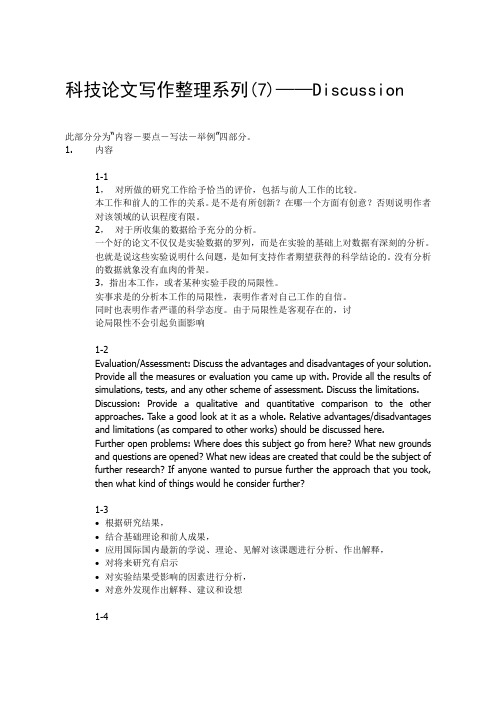
科技论文写作整理系列(7)——Discussion此部分分为―内容-要点-写法-举例‖四部分。
1.内容1-11,对所做的研究工作给予恰当的评价,包括与前人工作的比较。
本工作和前人的工作的关系。
是不是有所创新?在哪一个方面有创意?否则说明作者对该领域的认识程度有限。
2,对于所收集的数据给予充分的分析。
一个好的论文不仅仅是实验数据的罗列,而是在实验的基础上对数据有深刻的分析。
也就是说这些实验说明什么问题,是如何支持作者期望获得的科学结论的。
没有分析的数据就象没有血肉的骨架。
3,指出本工作,或者某种实验手段的局限性。
实事求是的分析本工作的局限性,表明作者对自己工作的自信。
同时也表明作者严谨的科学态度。
由于局限性是客观存在的,讨论局限性不会引起负面影响1-2Evaluation/Assessment: Discuss the advantages and disadvantages of your solution.Provide all the measures or evaluation you came up with. Provide all the results of simulations, tests, and any other scheme of assessment. Discuss the limitations.Discussion: Provide a qualitative and quantitative comparison to the other approaches. Take a good look at it as a whole. Relative advantages/disadvantages and limitations (as compared to other works) should be discussed here.Further open problems: Where does this subject go from here? What new grounds and questions are opened? What new ideas are created that could be the subject of further research? If anyone wanted to pursue further the approach that you took, then what kind of things would he consider further?1-3•根据研究结果,•结合基础理论和前人成果,•应用国际国内最新的学说、理论、见解对该课题进行分析、作出解释,•对将来研究有启示•对实验结果受影响的因素进行分析,•对意外发现作出解释、建议和设想1-4⑴背景材料:展开问题的提出;有关本研究的一些基本知识内容(不要离题太远)⑵本实验结果分析:各指标的意义(与文献值比较),结果说明什么问题⑶进一步对结果机理分析:结合文献⑷本工作的意义、结语或小结,进一步提出的新问题1-5I. Discussion (Comment)1. Purpose: to explain the nature and importance of the findings (Answers the questions: "So what?" and "Who cares?")2. Should be the most useful section but is often the weakest3. Begins by summarizing the study and the main results.4. Discusses the implication of the results and what else is known about the problem and its proposed solutions5. Generally includes the literature review6. State the limitations of the study7. List the conclusionsa. Distinguish between clinical and statistical significanceb. In studies with low statistical power, do not mistake inconclusive results for negative results ("absence of proof is not proof of absence")c. Distinguish between supported conclusions and speculation1-6结果和结论部分代表着文章的主要成就和贡献,论文有没有价值,值不值得读者阅读,主要取决于你所获得的结果和所得出的结论。
英文科技论文写作HOW_to_WRITE_Discussion
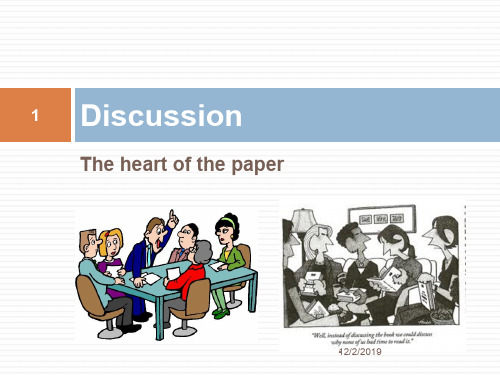
Our subject that remain to be explored is how to … More studies in … are needed …
12/2/2019
Take-Home Message: Conclusions
Relate your discussion back to the objectives and questions you raised in the Introduction section.
Limit your conclusions to those that your data can actually support. You can then proceed to speculate on why this occurred and whether you expected this to occur, based on other workers' findings.
species Give the big picture: do your findings help us
understand a broader topic?
12/2/2019
Discussion: summary
Free to explain what the results mean or why they differ from what other workers have found.
findings 3. Relate the findings to those of similar studies 4. State the theoretical or practical relevance or
科技英语交流(第2版)Lecture 7 How to write Discussion
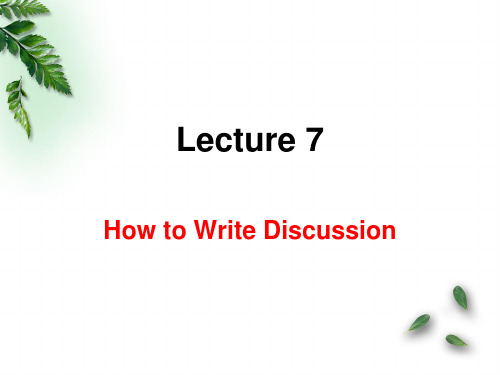
Why should we use hedges when commenting on our data?
➢ The extinction of the dinosaur
(恐龙)
may be is probably
due to the collision of a small planet onto the Earth.
➢ indicating achievement/contribution refining the implications
➢ limitations Current and future work Applications
2. Language focus
2.1 Adjectives in statements of contribution 2.2 “Limitations” in the Discussion section 2.3 Hedging
(2) The most striking aspect of the data indicates that tensile mechanical loads cause a rapid switch in the state of the collagen monomer converting it from “enzyme-susceptible” to “enzyme-resistant” at relatively low force values.
a. suggest b. appear to c. may d. exacerbate
Task 1: Identifying the hedges in the sample discussion
7 This study indicates that the benefits gained from stress-management intervention may
怎样写好科技篇英语作文
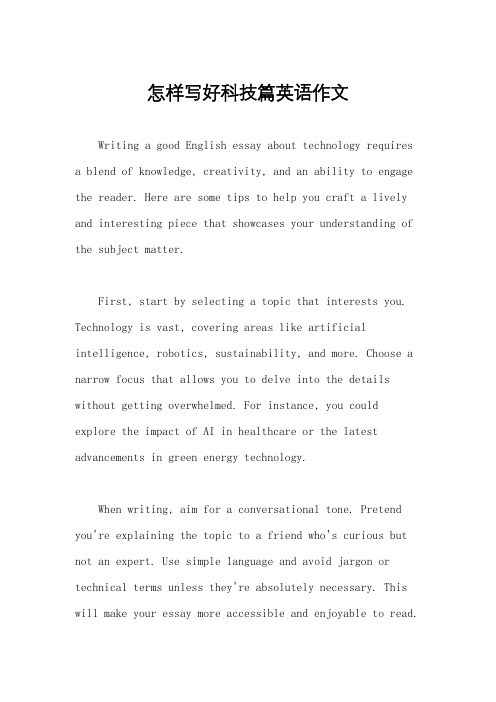
怎样写好科技篇英语作文Writing a good English essay about technology requires a blend of knowledge, creativity, and an ability to engage the reader. Here are some tips to help you craft a lively and interesting piece that showcases your understanding of the subject matter.First, start by selecting a topic that interests you. Technology is vast, covering areas like artificial intelligence, robotics, sustainability, and more. Choose a narrow focus that allows you to delve into the details without getting overwhelmed. For instance, you could explore the impact of AI in healthcare or the latest advancements in green energy technology.When writing, aim for a conversational tone. Pretend you're explaining the topic to a friend who's curious but not an expert. Use simple language and avoid jargon or technical terms unless they're absolutely necessary. This will make your essay more accessible and enjoyable to read.Each paragraph should have a clear focus. Describe a specific aspect of the technology, its applications, or its potential impacts. For example, in one paragraph, you might discuss how AI is being used to diagnose diseases more。
如何用英语讨论发明作文
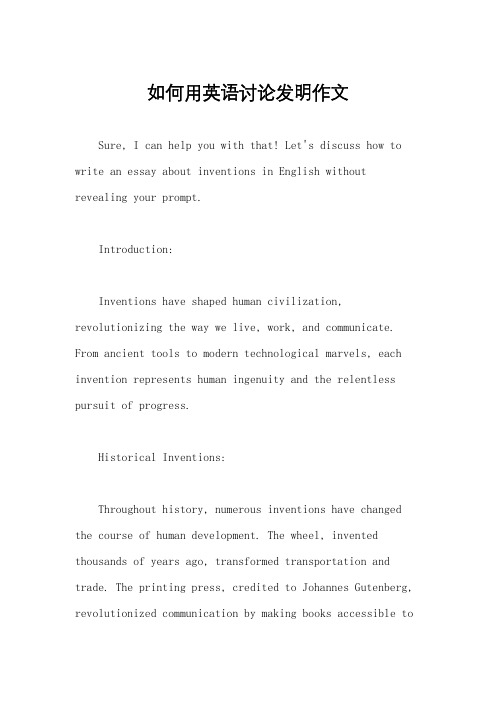
如何用英语讨论发明作文Sure, I can help you with that! Let's discuss how to write an essay about inventions in English without revealing your prompt.Introduction:Inventions have shaped human civilization, revolutionizing the way we live, work, and communicate. From ancient tools to modern technological marvels, each invention represents human ingenuity and the relentless pursuit of progress.Historical Inventions:Throughout history, numerous inventions have changed the course of human development. The wheel, invented thousands of years ago, transformed transportation and trade. The printing press, credited to Johannes Gutenberg, revolutionized communication by making books accessible tothe masses. The steam engine, pioneered by James Watt, powered the Industrial Revolution, leading to unprecedented economic growth.Impact on Society:Inventions have had a profound impact on society. The telephone, invented by Alexander Graham Bell, connected people across vast distances, revolutionizing communication. The light bulb, invented by Thomas Edison, illuminated homes and cities, transforming the way we live and work.The internet, a modern invention, has created a global network of information and communication, reshaping industries and social interactions.Technological Advancements:Recent decades have witnessed rapid technological advancements. The smartphone, combining communication, computing, and entertainment, has become an essential tool for billions worldwide. Artificial intelligence and machine learning technologies are revolutionizing industries suchas healthcare, finance, and transportation. Renewable energy innovations are addressing environmental challenges and reshaping the energy landscape.Challenges and Ethical Considerations:While inventions bring immense benefits, they also pose challenges and ethical considerations. Automation and AI raise concerns about job displacement and privacy. Genetic engineering and biotechnology raise questions about ethics and regulation. The digital divide highlights disparitiesin access to technology and information.Future of Inventions:Looking ahead, the future of inventions holds promise and challenges. Emerging technologies like quantum computing, nanotechnology, and space exploration are poised to redefine what is possible. Addressing global challenges such as climate change, healthcare accessibility, and sustainable development will require innovative solutions and collaborative efforts.Conclusion:In conclusion, inventions have played a pivotal role in shaping human history and progress. From ancient tools to modern marvels, each invention reflects human creativity, curiosity, and determination. As we navigate the complexities of the modern world, embracing innovationwhile addressing challenges responsibly will be key to shaping a better future for all.This essay explores the impact of inventions on society, the challenges they pose, and the potential of future innovations.。
如何解决科技问题英文作文

如何解决科技问题英文作文1. When facing technological problems, the first thing to do is to stay calm and not panic. Panicking will only make the situation worse and hinder your ability to think clearly.2. Take a moment to assess the problem and try to identify the root cause. Sometimes, the problem may not be as complicated as it seems, and a simple solution could be all that's needed.3. If you are unable to solve the problem on your own, don't be afraid to ask for help. There are plenty of online forums, tech support hotlines, and knowledgeable friends who may be able to offer guidance.4. Researching the issue online can also be a helpful way to find potential solutions. There are countless resources available that may have encountered the same problem and found a way to fix it.5. If all else fails, it may be time to seek professional help. Whether it's taking your device to a repair shop or hiring a tech expert, sometimes the best solution is to let someone with more expertise handle the problem.6. Prevention is key to avoiding future technological issues. Regularly updating software, backing up important data, and being cautious with downloads and emails can all help to minimize the risk of encountering problems in the future.。
如何解决科技问题英文作文
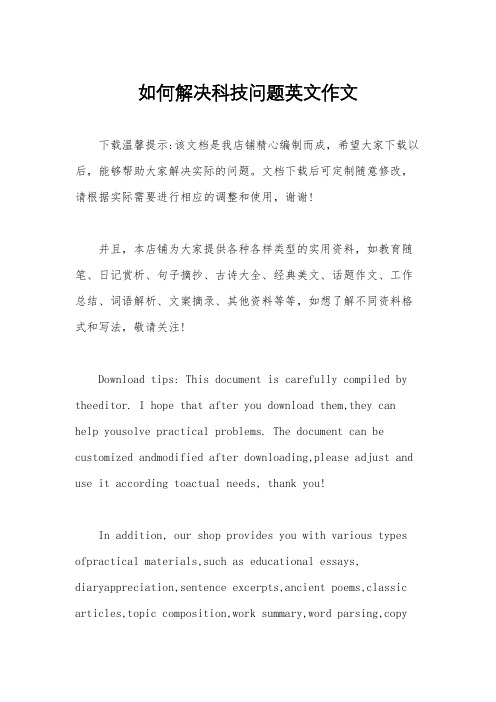
如何解决科技问题英文作文下载温馨提示:该文档是我店铺精心编制而成,希望大家下载以后,能够帮助大家解决实际的问题。
文档下载后可定制随意修改,请根据实际需要进行相应的调整和使用,谢谢!并且,本店铺为大家提供各种各样类型的实用资料,如教育随笔、日记赏析、句子摘抄、古诗大全、经典美文、话题作文、工作总结、词语解析、文案摘录、其他资料等等,如想了解不同资料格式和写法,敬请关注!Download tips: This document is carefully compiled by theeditor. I hope that after you download them,they can help yousolve practical problems. The document can be customized andmodified after downloading,please adjust and use it according toactual needs, thank you!In addition, our shop provides you with various types ofpractical materials,such as educational essays, diaryappreciation,sentence excerpts,ancient poems,classic articles,topic composition,work summary,word parsing,copyexcerpts,other materials and so on,want to know different data formats andwriting methods,please pay attention!Technology problems can be solved by first identifying the root cause of the issue. This may involve troubleshooting the hardware or software, or researching online for solutions.Sometimes, seeking help from tech support or customer service can be beneficial in resolving the problem. They may have the expertise and resources to provide a quick and effective solution.In some cases, updating the software or firmware canfix the issue. It's important to regularly check for updates to ensure that the technology is running smoothly.Another approach is to seek advice from online forums or communities where people share their experiences and solutions to similar technology problems.If all else fails, it may be necessary to seekprofessional help from a technician or IT specialist who can diagnose and fix the problem.In conclusion, technology problems can be solved through a combination of troubleshooting, seeking help from experts, and staying informed about updates and solutions.。
英语作文为科技献策
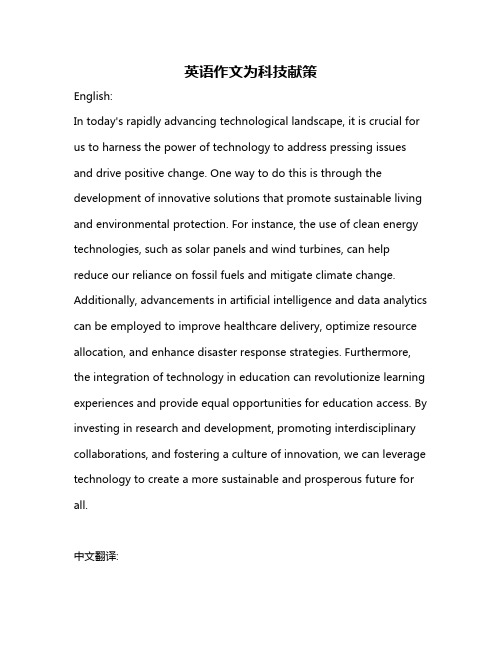
英语作文为科技献策English:In today's rapidly advancing technological landscape, it is crucial for us to harness the power of technology to address pressing issues and drive positive change. One way to do this is through the development of innovative solutions that promote sustainable living and environmental protection. For instance, the use of clean energy technologies, such as solar panels and wind turbines, can help reduce our reliance on fossil fuels and mitigate climate change. Additionally, advancements in artificial intelligence and data analytics can be employed to improve healthcare delivery, optimize resource allocation, and enhance disaster response strategies. Furthermore, the integration of technology in education can revolutionize learning experiences and provide equal opportunities for education access. By investing in research and development, promoting interdisciplinary collaborations, and fostering a culture of innovation, we can leverage technology to create a more sustainable and prosperous future for all.中文翻译:在当今飞速发展的科技领域,我们必须充分利用技术的力量来解决紧迫问题并推动积极变革至关重要。
如何撰写论文的讨论部分--10
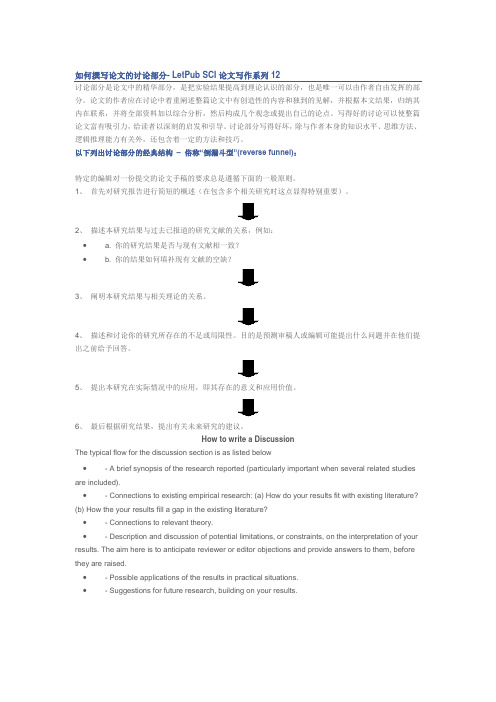
如何撰写论文的讨论部分- LetPub SCI论文写作系列12讨论部分是论文中的精华部分,是把实验结果提高到理论认识的部分,也是唯一可以由作者自由发挥的部分。
论文的作者应在讨论中着重阐述整篇论文中有创造性的内容和独到的见解,并根据本文结果,归纳其内在联系,并将全部资料加以综合分析,然后构成几个观念或提出自己的论点。
写得好的讨论可以使整篇论文富有吸引力,给读者以深刻的启发和引导。
讨论部分写得好坏,除与作者本身的知识水平、思维方法、逻辑推理能力有关外,还包含着一定的方法和技巧。
以下列出讨论部分的经典结构–俗称“倒漏斗型”(reverse funnel):特定的编辑对一份提交的论文手稿的要求总是遵循下面的一般原则。
1、首先对研究报告进行简短的概述(在包含多个相关研究时这点显得特别重要)。
2、描述本研究结果与过去已报道的研究文献的关系,例如:• a. 你的研究结果是否与现有文献相一致?• b. 你的结果如何填补现有文献的空缺?3、阐明本研究结果与相关理论的关系。
4、描述和讨论你的研究所存在的不足或局限性。
目的是预测审稿人或编辑可能提出什么问题并在他们提出之前给予回答。
5、提出本研究在实际情况中的应用,即其存在的意义和应用价值。
6、最后根据研究结果,提出有关未来研究的建议。
How to write a DiscussionThe typical flow for the discussion section is as listed below•- A brief synopsis of the research reported (particularly important when several related studies are included).•- Connections to existing empirical research: (a) How do your results fit with existing literature?(b) How the your results fill a gap in the existing literature?•- Connections to relevant theory.•- Description and discussion of potential limitations, or constraints, on the interpretation of your results. The aim here is to anticipate reviewer or editor objections and provide answers to them, before they are raised.•- Possible applications of the results in practical situations.•- Suggestions for future research, building on your results.。
- 1、下载文档前请自行甄别文档内容的完整性,平台不提供额外的编辑、内容补充、找答案等附加服务。
- 2、"仅部分预览"的文档,不可在线预览部分如存在完整性等问题,可反馈申请退款(可完整预览的文档不适用该条件!)。
- 3、如文档侵犯您的权益,请联系客服反馈,我们会尽快为您处理(人工客服工作时间:9:00-18:30)。
12/2/2019
Alternative Explanations of the Findings
10
Remember that the purpose of research is to discover and not to prove. Don’t fall into the trap – to prove
Relate to expectations and to literature Prove the hypotheses/Answered questions
The importance/significance of Your findings
Limitations Your conclusions/future works
12/2/2019
Discussion
14
The same information can have different meanings or significances to different people brainstorming
12/2/2019
Diesults fit into a broader context?
What do the findings mean? Why are they important?
“That make perfect sense!” (Why didn’t I think of this?)
12/2/2019
Always remember:
Introduction
Suggest the theoretical implications of your results.
Suggest practical applications of your results Extend your findings to other situations or other
Begin:
Our results confirm that … Our findings suggest that … The data show that … In this study, we found that ...
12/2/2019
Explain the meaning and importance of the findings
species Give the big picture: do your findings help us
understand a broader topic?
12/2/2019
Discussion: summary
Free to explain what the results mean or why they differ from what other workers have found.
12/2/2019
Make explanations complete
8
Discuss the results in the same order as in the “Results” one by one
Explain how your results relate to expectations and to literature cited in your Introduction
Previous findings:
Stimulated yours to Fill a gap, Correct their errors, invent a new method, …
Support yours – strength the importance of your studies
Broad Specific
Discussion
Specific
Broad
Moves from the narrow specific focus of the research to a more general view
Your goals/objectives
Your findings
Make recommendations, discuss future work
Our subject that remain to be explored is how to … More studies in … are needed …
12/2/2019
Take-Home Message: Conclusions
1 Discussion
The heart of the paper
1•2/2/2019
2
It may seem obvious that a scientific document is incomplete without the interpretation of the writer; it may not be so obvious that the document cannot "exist" without the interpretation of each reader.
conclusion
12/2/2019
State the major findings
5
In the first paragraph:
Begin (with a statement of the major findings A direct, declarative, succinct proclamation Should not include any data
13
What is the “take-home message”? What do you want the reader to remember
from your study?
The take-home message should be the first sentence of the conclusions section.
You only answered some questions, others related to this subject may remain ‘unanswered’
You should make suggestions for further studies and give a future perspective
Give evidence for each conclusion. Discuss possible reasons for expected and unexpected
findings Whether the experiments prove the hypotheses with
Should interpret your results in light of other published results, by adding additional information from sources you cited in the Introduction section as well as by introducing new sources.
6
No one has thought as long and as hard about your study as you have.
As the person who conceived, designed, and conducted the study, the meaning of the results and their importance seem obvious to you, but the findings might not be so clear for the readers who read your paper for the first time.
the highlight should be on the study data.
12/2/2019
Discussion: The Elements
4
1. State the study’s major findings 2. Explain the meaning and importance of the
journals have limitations!
Should know the limitations in your studies that might cause problems and possible explanation
Do not hide weak results behind bad writing Be sure to explain why results are weaker than you
expected
We used only …. Future research should include/ do … (differently,
use different …, use more …)
12/2/2019
Suggestions for Further Research
12
evidence (results). Do they agree, contradict, or are they exceptions to the
rule?
12/2/2019
Relate the findings to similar studies
9
Is your study so novel? (no relation to other studies?)No!Then, relate your findings to others.
